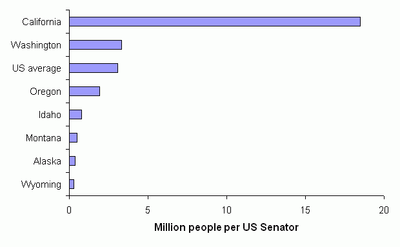How Democratic is the U.S. Senate?
1-The Issue
Today’s CONVO focuses on the U.S. Senate.
Democracy is based on the proposition that all people are created equal and deserve the same political rights. But does the U.S. Senate deliver on the democratic promise? Today’s CONVO is about how democratic the U.S. Senate is and what we should do about that. Join our CONVO to learn, discuss and act on this critical issue. Here’s how CONVO works.
The Big Question
How democratic is the U.S. Senate, and what should we do about that?
Related Questions to Consider
What is democracy, anyway?
Should other factors besides democracy be considered when constructing a political system?
Did the Framers value democracy and if so, why didn’t they use the word in the Constitution?
Was the Senate set up to be democratic in the first place?
Who does the current composition of the Senate most benefit and whom does it most hurt?
What would be the best way to change the Senate to make it more democratic?
Would it be Constitutional to alter the Senate?
Add your own question in the field below:
Student Questions in English Turkish translation
1-Why was the Senate even created, anyway? 1-Zaten Senato neden yaratıldı?
2-And how democratic is our entire political system either? 2-Siyasi sistemimiz ne kadar demokratiktir?
3-Why the heck are you translating into Turkish? 3-Neden halt türkçeye çeviri yapıyorsunuz?
4- Do you really think this is funny, troll! 4- Bunun gerçekten komik olduğunu düşünüyor musunuz, troll!
Survey - Twitter poll
Before we learn more about this, share your opinion - take our Twitter Poll
Is the U.S. Senate democratic?
Is the U.S. Senate democratic?
— AP US Government (@UsGoPoPro) February 13, 2019
Tell us what you think and then join us in our Senate CONVO! https://t.co/p5LepWrWl6 #apgov #apgopo #hsgovchat @MCMartirone @RAPLewis @vicpasquantonio @Caro_Thompson @MrW_THS
2-Research and Share
Use your brain to learn all about today’s critical issue with these facts, data, maps, charts, visuals, videos, and more.
What?
First some background.
The Senate was created at the Constitutional Convention of 1787 as a part of the “Great Compromise.”
The United States did not always have a bicameral legislature (two chambers: the House and the Senate) Initially, the Founding Fathers, or “framers” of the U.S. Constitution, drafted a document called the Articles of Confederation, which was written in 1777 and ratified in 1781. The Articles established a unicameral Congress and the Supreme Court, but no Office of the President. What the what!?!
This original Congress was made up of members elected by each of the states, which were represented equally. Thus small states like Delaware had the same representation as large states like New York. Way? Way!
Undecided, at the Philadelphia Convention was how the Congress would be composed (unicameral, bicameral) and how it would be apportioned (based on the population, or simple the same for each state). Small states like Rhode Island feared they would be overwhelmed by the voting power of large states like Virginia, and demanded a Senate in return for ratification. The small states essentially held the Constituiton hostage over their demand for equal representation for all states (not people). This seems very undemocratic, at the same time, had the Senate not been added to the Constitution, we would not have a United States of America. You can read more about the history of the U.S. Senate. The Senate was not created to be democratic -quite the opposite; and this undemocratic legacy remains with us today.
the numbers
The U.S. Constitution created the United States Senate with equal representation — two senators — from each of the country’s states, despite the wide variation in population from state to state. Fair or not, throughout the country’s history the Senate typically passed legislation, nominations, and other matters with broad support. Most votes passed with around 68% of senators voting yes, with those senators representing about 68% of the U.S. population. If the allotment of senators was unfair in principle, it seems to have been fair in practice.
But 2017 was an unprecedented year. In 2017, for the first time, the Senate’s decisions were often made by a coalition of states representing less than half of the country’s population. The median share of senators supporting passed bills, confirmed judges and agency leaders, and other matters dropped to 58% (the lowest since 1930), with those senators representing just 49.5% of the U.S. population (the lowest ever)!
The 17th Amendment
The 17th Amendment made the Senate more democratic by allowing for the direct election of Senators by the people of each state.
Words
A voter in Wyoming enjoys roughly 70 times more influence in the Senate as a voter in California, which sounds like the most unfair statistic in American politics, until you remember that taxpaying U.S. citizens in Washington, D.C. and Puerto Rico still have no influence in the Senate at all.
When the Constitution was first adopted, the largest state had fewer than 10 times the voters per senator as the smallest; now, that ratio is 72.
A slight majority of Americans live in just nine states. They have 18 votes in the Senate, while the minority holds 82 seats.
More to the point, it would be very strange indeed if there weren't a gap between Senate vote shares and seat shares. The Senate was purposefully set up as an anti-democratic institution meant to privilege the voices of Connecticut residents above those in, say, New York. That was what small states' representatives demanded at the Constitutional Convention in 1787, and it's what they got, over the opposition of those like Alexander Hamilton and James Madison who thought that giving each state the same number of votes was hideously unfair. Moreover, until 1913, the Senate wasn't even popularly elected.
Again, from The Federalist No. 22:
Every idea of proportion and every rule of fair representation conspire to condemn a principle, which gives to Rhode Island an equal weight in the scale of power with Massachusetts, or Connecticut, or New York; and to Delaware an equal voice in the national deliberations with Pennsylvania, or Virginia, or North Carolina. Its operation contradicts the fundamental maxim of republican government, which requires that the sense of the majority should prevail. Sophistry may reply, that sovereigns are equal, and that a majority of the votes of the States will be a majority of confederated America. But this kind of logical legerdemain will never counteract the plain suggestions of justice and common-sense. It may happen that this majority of States is a small minority of the people of America; and two thirds of the people of America could not long be persuaded, upon the credit of artificial distinctions and syllogistic subtleties, to submit their interests to the management and disposal of one third.
Hamilton hated—hated—the compromise under which the Constitutional Convention was blackmailed into giving every state the same number of senators regardless of population. In the essay quoted above, he is ostensibly railing against the Articles of Confederation. Obviously, though, his argument would apply with equal force to Article I, Section 3 of the Constitution that he, James Madison, and John Jay were madly scribbling in defense of.
The Constitution
Now share your thoughts on our Convo Forum
Check out the Convo Forum Template to get an idea of how this works.
Then open the Convo Forum Senate, make a copy for each of your classes, then have your students fill in their class forum.
Elite Opinion
Don’t Change the Senate
The Senate is Not Undemocratic - By Jonah Goldberg on October 17, 2018 in National Review Online
Liberals who complain that the Senate is undemocratic are really just whining about California - By Jonah Goldberg on October 16, 2018 in the LA Times.
Change the Senate
The Case for Abolishing the Senate - By Jay Wills on October 16, 2018 in GQ
The Senate is undemocratic and it matters - By Dylan Matthews on January 6, 2015 in Vox
You Can’t Change the Senate
Revamping the Senate Is a Fantasy - By Noah Feldman on October 10, 2018 in Bloomberg
Practice
3- Listen and Discuss
Use Your Ears and Join us as we Listen and Discuss today’s critical issue.
Students discuss the topic in a setting that maximizes listening.
4-Write
Use Your Words
Students write a post-discussion Editorial about the topic to persuade the reader of their position. Students must use and name at least one source from the forum in their editorial.
5-Act
Do Something
Students act on what they have learned about the topic. Students can work alone or in teams to turn their learning into action. Here is a list of Critical Actions students can take.












